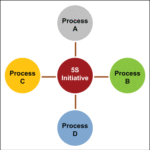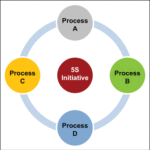
The process improvement tool 5S (sort, straighten, shine, standardize, sustain) sounds like a simple concept to implement – and it is. But its simplicity is sometimes the cause of its early demise – it is easy to “do” 5S without much effort or strategic coordination, and thus without as much effect as possible.
A 5S initiative can fall broadly into one of two categories: 1) department-specific wherein each department manages the 5S initiatives specific to the department, or 2) corporate-wide wherein designated teams independent of the departments deploy and manage the 5S initiatives. A successful 5S deployment path is one that is aligned with a company’s strategic plan and priorities, optimizing resources to add value.
Whether department-specific or corporate-wide, the 5S initiative that is most likely to lead to the best results is the one that follows the integrated-with-the-process model of implementation. Here, the 5S elements are embedded within day-to-day operational processes. This model can be contrasted with a stand-alone model, in which 5S is executed independently of processes. Table 1 compares the integrated-with-the-process model to the stand-alone model.
| Table 1: 5S Deployment Models | ||
| 5S Integrated-with-process Model | 5S Stand-alone 5S Model | |
| Graphic Representation | ||
| Example | Assembly operators check line clearance (e.g., only acceptable parts needed for the batch in-process should be in the assembly line for processes A-D) prior to the start of each batch assembly per operations’ start-up log. | 5S team members (not necessarily the process owners) use a 5S checklist to verify area compliance to sorting non-conforming parts and organization of each assembly line once a week. |
| Measure of Success | First article inspection or scrap rate trend due to wrong material. | Completion and correction of findings listed in the 5S checklist. |
| Point of Differentiation | In this example, 5S elements (i.e., verification of correct parts) are integrated in the operational execution of Processes A-D (i.e., the performance of line clearance). Thus, this is an example of an integrated-with-the-process model. | In this example, 5S elements (i.e., verification of parts sorting and organization) are performed as independent tasks and not part of Processes A-D. Thus, this is an example of a stand-alone model. |
Why Use the 5S Integrated–with-the-process Model?
Both 5S models shown in Table 1 have the same intent – deploying 5S – but the examples reveal that the integrated-with-the model process may be more effective as it provides timely feedback, visible accountability and the opportunity for immediate mitigation. The integration of the 5S elements into the core processes promotes the dynamic interaction of the 5S elements within the system that would likely increase its sustainability; the 5S stand-alone model may require more maneuvering by team members to ensure the dynamic relationship with the processes.
With the integrated-with-the process model, a 5S initiative is exposed to the same critical-to-quality requirements that the operational processes are, including customer requirements, operational costs, risk, etc. Therefore, this model has more opportunities for aligning 5S activities with business priorities and added value in comparison to the stand-alone model.
Table 2 further illustrates the benefits of the 5S integrated-with-the-process model in comparison to the stand-alone model.
| Table 2: Further Comparison of 5S Deployment Models – More Examples of Use | |||
| Examples of Core Processes | Actions/Benefits | 5S Integrated-with-process Model | Stand-alone 5S Model |
| Assembly line clearance | 5S Activity | Operators’ perform line clearance (sort) prior to start of each shift or batch | 5S team verifies periodically that designated material bin are allocated for each line for removal of material from previous jobs (sort) |
| Example Metric | First pass yield/rework due to wrong parts | Compliance to organization requirement | |
| Point of Differentiation | This method is dynamic and provides immediate feedback to the batch quality performance; promotes direct accountability of responsibility. | This method gives passive results and does not immediately correct non-conformances. | |
| Inventory management | 5S Activity | Assessment of stockroom’s racks’ organization for accuracy compliance rated by receiver of parts (straighten) | Assessment of stockroom’s racks’ organization for accuracy compliance rated by the 5S auditor on a periodic basis (straighten) |
| Example Metric |
|
Number of sampled racks containing accurate parts | |
| Point of Differentiation | This method promotes actionable observations leading to measurable performance improvement of related processes. | This method’s focus is limited (i.e., accuracy of sampled racks) and does not measure the impact on related processes. | |
| Clean room process | 5S Activity | Clean room compliance to proper clean room gowning rated through tests directly related to compliance of clean room requirements (shine) | Clean room compliance to proper clean room gowning by observing and listing frequency of observations rated by supervisor (shine) |
| Example Metric |
|
Frequency of non-compliance to procedures | |
| Point of Differentiation | This method provides a quantitative measurement of a successful compliance against a standard (i.e., effectiveness of clean room gowning). | This method does not pinpoint action items as the metric does not show impact on a critical-to-quality characteristic. | |
| Trailers’ floor cleanliness inspection | 5S Activity | Maintenance of trailer cleanliness monitored through dock supervision walk for all shifts (sustain). Dock supervision is available on all shifts and walk through is performed as a routine task (no additional labor required for dock walk) | Material handlers are to complete a trailer 5S checklist as evidence that 5S–related tasks are completed, example: sweep floors prior to loading to prevent potential damage to freight (sustain) |
| Example Metric | Results of spot checking | Completion of the checklist | |
| Point of Differentiation | This approach offers real-time feedback and opportunity for immediate correction. This method also promotes accountability as well as continuous training of the workforce. | This approach is passive and non-verifiable (another checklist to complete and file away). | |
Do’s for a Successful 5S Initiative
- Keep the initiative simple, not cumbersome
- Define the company’s success metrics that will provide the optimum added value to the system
- Review the initiative periodically to ensure initiative has not been “outgrown” by process changes
Prioritize areas of implementation based on risk assessment and cost list only the tasks that can be realistically achieved. For example, it may add more value to prioritize 5S implementation in critical areas (such as dock operations for a logistic company) rather than areas with lesser variability (such as the administrative offices).
5S initiative designers may not necessarily be part of the larger process improvement deployment team especially for bigger organizations. Therefore, deployment-level process improvement leaders would be well served to set up a periodic follow-up mechanism with the 5S process owners to identify any major process changes that may require adjustment or re-designing of the 5S deployment model. Metrics may send signals that items need to be adjusted; for example, constant failure may mean that expectations are exceeding capability.
An escalation path for addressing the continuing effectiveness of the 5S intent needs to be part of the design of the initiative. The escalation path may be as simple as reviewing a monthly trending of results versus goals with process managers.
More Than a Checklist
Claiming to have a 5S program is not as simple as having a 5S checklist. 5S is more than a form or a procedure – it is a discipline that needs to be understood, embraced, implemented and continually measured by the workforce for the program to be effective and add value. If used properly, this is a powerful improvement tool that is simple and inexpensive.

